When I first started seeing my partner, he mentioned his love of internet games. Naively, I asked him to tell me more about his favourite game, League of Legends. Fast forward 3 hours, and I realized words like “jungle”, “AD carry”, and “gank” were fast becoming part of the vocabulary I would hear on a regular basis.
Although I didn’t understand most of what he was saying, and he enjoyed playing these games for long periods of time, I didn’t think more of it. Anyways I, myself, had spent many hours watching whole seasons of my favourite shows in one go. But what I didn’t understand then was that these virtual internet games carried potential risks to my partner’s mental health.
Over 20 million people worldwide play massive multiplayer virtual games, like League of Legends and World of Warcraft. And with numbers increasing annually, there is growing concern that gaming may evolve into a behavioural addiction known as Internet Gaming Disorder, or IGD.
It was amid the number of media reports that I began to wonder: Is my partner at risk?
So when I was asked to interview Kevin Chen, lead author of MHR’s newly published paper, Internet Gaming Disorder: An Emergent Health Issue for Men, I was eager to learn more. Chen, a nurse practitioner in Vancouver, became interested in IGD when he noticed that the disorder mainly affected men. “Anecdotally, I’ve noted a trend that whenever there is an incident of severe addiction to gaming it’s always a guy,” said Chen, “so with this review, we aimed to look at describing IGD and the implications for men’s health.”
Internet Gaming Disorder
Contrary to the notion that gaming is only for adolescents, the review found that the average age of gamers is around 30 years old. The amount of time devoted to gaming ranged across ages, but overall, males played more than females. “Games tend to be marketed more towards males,” said Chen, “this may in part account for why we see a higher vulnerability to IGD in men.”
Concerns around the negative physical and psychosocial impacts ranged from sleep deprivation and decreased school and work performance, to relationship and self-care issues.
“Not only did gaming often lead to poor communication, it basically took away the ability of the individual to interact with other human beings,” said Chen. This is especially true for partners or spouses who live with the gamer. “The needs of their significant others, whether emotional, physical, or financial are often neglected,” said Chen.
Most research on IGD has looked at how it affects the brain. In fact, research shows that in those with suspected IGD there are changes in the brain that are similar to those who have substance use disorders. While much has been done from this biomedical standpoint, Chen and co-authors wanted to look at IGD from a different view. “We wanted to stray away from the classic biomechanical studies and take a social behavioural lens to IGD, because currently there isn’t anything linking the two. No insight on how gender, or masculinity may impact the potential for IGD,” said Chen.
But why men?
The increase in mental illness in young men has been linked to social isolation, as well as traditional masculine practices like self-reliance and stoicism. These norms dictate men should internalize their problems and many may use maladaptive behaviours, like gaming, to cope.
“Given the social norms around masculinity, men are often quite hesitant to ask for help, and even if they want to, they may not actually know how. So, to avoid this, men turn to things like gaming, especially virtual games, because it provides an environment where they can escape their problems,” said Chen.
What draws men to game?
The scoping review found that there were three common factors that draw men to gaming and increase their risk of IGD: achievement, sociability, and immersion. In concert, these factors create an environment that enable men to feel powerful, connected, and competitive.
“The virtual game world not only allows men to fulfill the social construct of masculinity through feeling powerful by advancement and reputation in the gaming world, but it’s also a common portal of social interaction for guys. For those that are more introverted, it is a great way for them to stay in their “safe zones”, yet still make friends with others,” said Chen, “As well, gamers are able to escape real life by immersing themselves in the game, which may help them to avoid negative moods and thoughts.”
Digging Deeper
So armed with little evidence to guide them on diagnosing and treating IGD, what are health care providers to do? Chen recommends they dig a little deeper, “IGD can be a mask for other mental illness, such as depression, or loneliness. There is always something that attracts the gamers to hide themselves in this virtual world – so health care providers should make sure they do thorough mental health exams because there may be a potential for other underlying conditions,” said Chen.
What’s next?
Currently there is no standard treatment for IGD, although cognitive behavioural therapy is commonly used. With the American Psychiatric Association recently including IGD in the DSM-5 as a condition that warranted further clinical research, Chen hopes this review will help contribute to the much-needed evidence-base to get it formally added as a mental disorder.
“So we are seeing more incidents but our understanding of it, especially in relation to men, are not catching up. Somehow this has been missed, a trend is there, but no one has paid attention to it. I would very much like to understand more in order to help and intervene in the earlier stages.”
In hopes of pushing for more conversation, Chen and his coauthors hope that this will help to enhance the current biomed and psychiatric approaches to this behavioural gendered addiction.
